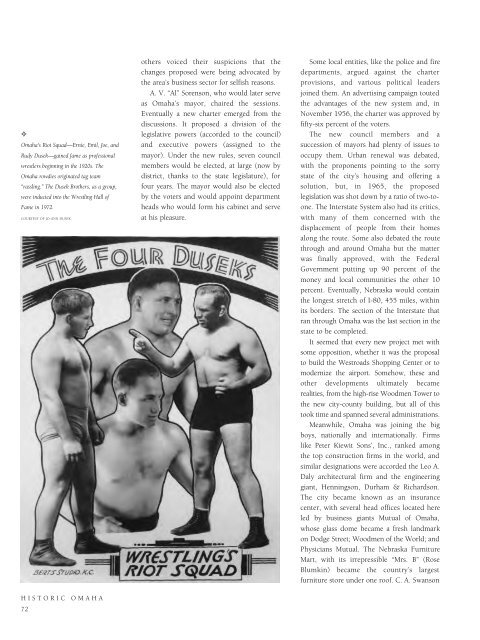Historic Omaha
An illustrated history of Omaha and the Douglas County area, paired with the histories of companies, families and organizations that make the region great.
An illustrated history of Omaha and the Douglas County area, paired with the histories of companies, families and organizations that make the region great.
You also want an ePaper? Increase the reach of your titles
YUMPU automatically turns print PDFs into web optimized ePapers that Google loves.
✧<br />
<strong>Omaha</strong>'s Riot Squad—Ernie, Emil, Joe, and<br />
Rudy Dusek—gained fame as professional<br />
wrestlers beginning in the 1920s. The<br />
<strong>Omaha</strong> rowdies originated tag team<br />
“rassling.” The Dusek Brothers, as a group,<br />
were inducted into the Wrestling Hall of<br />
Fame in 1972.<br />
COURTESY OF JO-ANN DUSEK.<br />
HISTORIC OMAHA<br />
72<br />
others voiced their suspicions that the<br />
changes proposed were being advocated by<br />
the area’s business sector for selfish reasons.<br />
A. V. “Al” Sorenson, who would later serve<br />
as <strong>Omaha</strong>’s mayor, chaired the sessions.<br />
Eventually a new charter emerged from the<br />
discussions. It proposed a division of the<br />
legislative powers (accorded to the council)<br />
and executive powers (assigned to the<br />
mayor). Under the new rules, seven council<br />
members would be elected, at large (now by<br />
district, thanks to the state legislature), for<br />
four years. The mayor would also be elected<br />
by the voters and would appoint department<br />
heads who would form his cabinet and serve<br />
at his pleasure.<br />
Some local entities, like the police and fire<br />
departments, argued against the charter<br />
provisions, and various political leaders<br />
joined them. An advertising campaign touted<br />
the advantages of the new system and, in<br />
November 1956, the charter was approved by<br />
fifty-six percent of the voters.<br />
The new council members and a<br />
succession of mayors had plenty of issues to<br />
occupy them. Urban renewal was debated,<br />
with the proponents pointing to the sorry<br />
state of the city’s housing and offering a<br />
solution, but, in 1965, the proposed<br />
legislation was shot down by a ratio of two-toone.<br />
The Interstate System also had its critics,<br />
with many of them concerned with the<br />
displacement of people from their homes<br />
along the route. Some also debated the route<br />
through and around <strong>Omaha</strong> but the matter<br />
was finally approved, with the Federal<br />
Government putting up 90 percent of the<br />
money and local communities the other 10<br />
percent. Eventually, Nebraska would contain<br />
the longest stretch of I-80, 455 miles, within<br />
its borders. The section of the Interstate that<br />
ran through <strong>Omaha</strong> was the last section in the<br />
state to be completed.<br />
It seemed that every new project met with<br />
some opposition, whether it was the proposal<br />
to build the Westroads Shopping Center or to<br />
modernize the airport. Somehow, these and<br />
other developments ultimately became<br />
realities, from the high-rise Woodmen Tower to<br />
the new city-county building, but all of this<br />
took time and spanned several administrations.<br />
Meanwhile, <strong>Omaha</strong> was joining the big<br />
boys, nationally and internationally. Firms<br />
like Peter Kiewit Sons’, Inc., ranked among<br />
the top construction firms in the world, and<br />
similar designations were accorded the Leo A.<br />
Daly architectural firm and the engineering<br />
giant, Henningson, Durham & Richardson.<br />
The city became known as an insurance<br />
center, with several head offices located here<br />
led by business giants Mutual of <strong>Omaha</strong>,<br />
whose glass dome became a fresh landmark<br />
on Dodge Street; Woodmen of the World; and<br />
Physicians Mutual. The Nebraska Furniture<br />
Mart, with its irrepressible “Mrs. B” (Rose<br />
Blumkin) became the country’s largest<br />
furniture store under one roof. C. A. Swanson
















